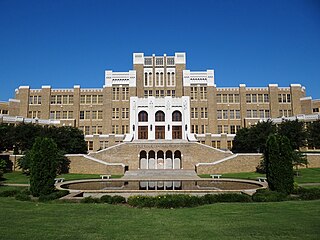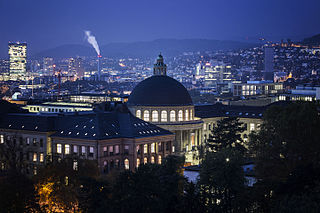
A primary school, elementary school, or grade school is a school for primary education of children who are 4 to 10 years of age. Primary schooling follows preschool and precedes secondary schooling.

A student is a person enrolled in a school or other educational institution.

Gymnasium is a term in various European languages for a secondary school that prepares students for higher education at a university. It is comparable to the US English term preparatory high school. Before the 20th century, the gymnasium system was a widespread feature of educational systems throughout many European countries.
The lyceum is a category of educational institution defined within the education system of many countries, mainly in Europe. The definition varies among countries; usually it is a type of secondary school. Basic science and some introduction to specific professions are generally taught.

A secondary school or high school is an institution that provides secondary education and also usually includes the building where this takes place. Some secondary schools provide both lower secondary education and upper secondary education, i.e., both levels 2 and 3 of the ISCED scale, but these can also be provided in separate schools.

Paolo Emanuele Borsellino was an Italian judge and prosecuting magistrate. From his office in the Palace of Justice in Palermo, Sicily, he spent most of his professional life trying to overthrow the power of the Sicilian Mafia. After a long and distinguished career, culminating in the Maxi Trial in 1986–1987, on 19 July 1992, Borsellino was killed by a car bomb in Via D'Amelio, near his mother's house in Palermo.

The education system in Switzerland is very diverse, because the constitution of Switzerland delegates the authority for the school system mainly to the cantons. The Swiss constitution sets the foundations, namely that primary school is obligatory for every child and is free in state schools and that the confederation can run or support universities.
Education in Italy is compulsory from 6 to 16 years of age, and is divided into five stages: kindergarten, primary school, lower secondary school, upper secondary school and university (università). Education is free in Italy and free education is available to children of all nationalities who are residents in Italy. Italy has both a private and public education system.
Education in Cuba has been a highly ranked system for many years. The University of Havana was founded in 1727 and there are a number of other well-established colleges and universities. Following the 1959 revolution, the Castro government nationalized all educational institutions, and created a government operated system. Education expenditures continue to receive high priority.

Education in Eritrea is officially compulsory between 7 and 16 years of age. Important goals of Eritrea's educational policy are to provide basic education in each of Eritrea's mother tongues as well as to produce a society that is equipped with the necessary skills to function with a culture of self-reliance in the modern economy. The education infrastructure is currently inadequate to meet these needs.

Education in Nepal has been modeled on the Indian system, which is in turn the legacy of the old British Raj. The National Examinations Board (NEB) supervises all standardized tests. The Ministry of Education is responsible for managing educational activities in Nepal. The National Center for Educational Development (NCED) is Nepal's teacher-training body.

Liceo scientifico is a type of secondary school in Italy. It is designed to give students the skills to progress to any university or higher educational institution. Students can attend the liceo scientifico after successfully completing middle school.

The liceo classico or ginnasio is the oldest public secondary school type in Italy. Its educational curriculum spans over five years, when students are generally about 14 to 19 years of age.
Muckross Park College is a non fee paying Catholic secondary school for girls, located in Donnybrook, Dublin, Ireland. Founded in 1900, the curriculum is traditional, with a broad general programme of subjects and a compulsory Transition year programme. Muckross is one of a number of Dominican schools in Ireland. It has a student body of 708.

Loreto College Marryatville is an independent Roman Catholic primary and secondary day and boarding school for girls in Marryatville, an inner-eastern suburb of Adelaide located about 4 kilometres (2.5 mi) from the Adelaide city centre, in South Australia, Australia.

Addiopizzo is a grassroots movement established in Sicily to build a community of businesses and consumers who refuse to pay "pizzo"—Mafia extortion money. It is a grassroots social-conscience motivated consumer movement analogous to Fair Trade. The group, led by a generation whose adolescence was characterized by the murders of anti-Mafia judges, journalists and businessmen, operates in the Palermo and Catania metropolitan areas, traditionally Mafia strongholds.
The Gentile Reform of 1923 was a reform of the Italian educational system through a series of normative acts, by the neo-idealist philosopher Giovanni Gentile, minister of education in Benito Mussolini's first cabinet. It officially recognized 21 universities in Italy.
The International School of Lausanne (ISL) is a luxury English-language private school located in the village of Le Mont-sur-Lausanne, just north of Lausanne, Switzerland. ISL was established as the English School of Lausanne in 1962, serving the needs of international and local families for an international primary or secondary education.
Secondary education in Italy lasts eight years and is divided in two stages: scuola secondaria di primo grado, also known as scuola media, corresponding to the ISCED 2011 Level 2, middle school and scuola secondaria di secondo grado, which corresponds to the ISCED 2011 Level 3, high school. The middle school lasts three years from the age of 11 to age 14, and the upper secondary from 14 to 19.












